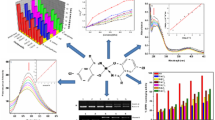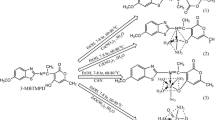Abstract
Synthesis of new metallic complex of cobalt and zinc with amino acid-nucleobase hybrid ligand have been achieved by simple chemical reaction of metal salt with amino acid L-histidine and nucleobase adenine as ligands. Various physicochemical techniques such as elemental analysis, conductometric measurements, FT-IR, UV-visible, 1H & 13C NMR, mass spectroscopy and magnetic measurements were employed to characterize the complexes. The results confirmed the formation of the ligand and the complex. The interaction of the complex with calf thymus DNA (CT-DNA) has been carried out using UV-visible titration, fluorescence spectroscopy, cyclic voltammetry and viscosity measurements. The intrinsic binding constant (Kb) and Stern-Volmer constant (Ksv) of the complexes have been calculated. The cleavage activity of the ligand and the complexes with pBR322 DNA was further confirmed by gel electrophoretic technique. The pharmacological activity of the ligand and the complexes was investigated by antioxidant, antimicrobial and cytotoxic activity, and they show promising pharmacological effect. The results of the molecular docking studies of the ligand and the complexes reinforce all the above facts.









Similar content being viewed by others
References
Abdel-Rahman LH, El-Khatib RM, Nassr LA, Abu-Dief AM, Lashin FE (2013) Design, characterization, teratogenicity testing, antibacterial, antifungal and DNA interaction of few high spin Fe (II) Schiff base amino acid complexes. Spectrochim Acta A 111:266–276
Wang PH, Keck JG, Lien EJ, Lai MM (1990) Design, synthesis, testing, and quantitative structure-activity relationship analysis of substituted salicylaldehyde Schiff bases of 1-amino-3-hydroxyguanidine tosylate as new antiviral agents against coronavirus. J Med Chem 33(2):608–614
Mai JC, Mi Z, Kim SH, Ng B, Robbins PD (2001) A proapoptotic peptide for the treatment of solid tumors. Cancer Research Cancer Res 61(21):7709–7712
Risso A, Braidot E, Sordano MC, Vianello A, Macrì F, Skerlavaj B, Zanetti M, Gennaro R, Bernardi P (2002) BMAP-28, an antibiotic peptide of innate immunity, induces cell death through opening of the mitochondrial permeability transition pore. Mol Cell Boil 22(6):1926–1935
Cruciani RA, Barker JL, Zasloff M, Chen HC, Colamonici O (1991) Antibiotic magainins exert cytolytic activity against transformed cell lines through channel formation. P Natl Acad Sci USA 88(9):3792–3796
Hatse S, Naesens L, Degréve B, Segers C, Vandeputte M, Waer M, Clercq ED, Balzarini J (1998) Potent antitumor activity of the acyclic nucleoside phosphonate 9-(2-phosphonylmethoxyethyl) adenine in choriocarcinoma-bearing rats. Int J Cancer 76(4):595–600
Ghosh PK, Mandal HK, Mahapatra A (2010) Interaction of adenine with dichloro-[1-alkyl-2-(naphthylazo)-imidazole] palladium (II) complexes: kinetic and mechanistic studies. Transit Metal Chem 35(6):679–687
Mesu JG, Visser T, Soulimani F, Weckhuysen BM (2005) Infrared and Raman spectroscopic study of pH-induced structural changes of L-histidine in aqueous environment. Vib Spectrosc 39(1):114–325
Remko M, Fitz D, Rode BM (2010) Effect of metal ions (Li+, Na+, K+, Mg2+, Ca2+, Ni2+, Cu2+ and Zn2+) and water coordination on the structure and properties of l-histidine and zwitterionic l-histidine. Amino Acids 39(5):1309–1319
Song YM, Wu Q, Yang PJ, Luan NN, Wang LF, Liu YM (2006) DNA Binding and cleavage activity of Ni (II) complex with all-trans retinoic acid. J Inorg Biochem 100(10):1685–1691
Tan J, Wang B, Zhu L (2009) DNA binding, cytotoxicity, apoptotic inducing activity, and molecular modeling study of quercetin zinc (II) complex. Bioorgan Med Chem 17(2):614–620
Friedman AE, Chambron JC, Sauvage JP, Turro NJ, Barton JK (1990) A molecular light switch for DNA: Ru (bpy) 2 (dppz) 2+. J Am Chem Soc 112(12):4960–4962
Metcalfe C, JA T (2003) Kinetically inert transition metal complexes that reversibly bind to DNA. Chem Soc Rev 32(4):215–224
Van Rijt SH, Sadler PJ (2009) Current applications and future potential for bioinorganic chemistry in the development of anticancer drugs. Drug Discov Today 14(23):1089–1097
Reddy PR, Radhika M, Rao KS (2004) Interaction of zinc and cobalt with dipeptides and their DNA binding studies. J Chem Sci 116(4):221–226
Reddy PR, Radhika M, Manjula P (2005) Synthesis and characterization of mixed ligand complexes of Zn (II) and Co (II) with amino acids: Relevance to zinc binding sites in zinc fingers. J Chem Sci 117(3):239–246
Bandyopadhyay S, Mukherjee GN, Drew MG (2006) Equilibrium studies on mixed ligand complex formation of Co (II), Ni (II), Cu (II) and Zn (II) with N-(2-hydroxybenzyl)-l-histidine (H 2 hb-l-his) and typical N, N donor ligands: Crystal structure of [Ni (hb-l-his)(bipyridine)]· H 2 O complex. Inorg Chim Acta 359(10):3243–3251
Wang YF, Li RF, Wang QL, LH Y, Yang GM, Liao DZ (2004) Synthesis, structure and properties of two bimetallic compounds [Co (bpy) 2 (NiL)](ClO4) 2 and {[Co (phen) 3](NiL)}(ClO4) 2 containing a macrocyclic oxamide ligand. Transit Metal Chem 29(7):728–731
Perrin DD, Armarego WL, Perrin DR (1980) Purification of Laboratory Chemicals, 2nd edn. Pergamon Press, Oxford
Marmur J (1961) A procedure for the isolation of deoxyribonucleic acid from micro-organisms. J Mol Biol 3(2):208–IN1
Eriksson M, Leijon M, Hiort C, Norden B, Graeslund A (1994) Binding of DELTA.-and LAMBDA.-[Ru (phen) 3] 2+ to [d (CGCGATCGCG)] 2 studied by NMR. Biochemistry-US 33(17):5031–5040
Xiong Y, He XF, Zou XH, JZ W, Chen XM, Ji LN, Li RH, Zhou JY, Yu KB (1999) Interaction of polypyridyl ruthenium (II) complexes containing non-planar ligands with DNA. Dalton Trans (1):19–24
Sabolová D, Kožurková M, Plichta T, Ondrušová Z, Hudecová D, Šimkovič M, Paulíková H, Valent A (2011) Interaction of a copper (II)–Schiff base complexes with calf thymus DNA and their antimicrobial activity. Int J Biol Macromol 48(2):319–325
Vujčić M, Tufegdžić S, Vujčić Z, Gašić MJ, Sladić D (2007) Interactions of the anti-tumor sesquiterpene hydroquinone avarol with DNA in vitro. J Serb Chem Soc 72(12):1265–1269
Yoon I, Park HS, Cui BC, Li JZ, Kim JH, Lkhagvadulam B, Shim YK (2011) Photodynamic and Antioxidant Activities of Divalent Transition Metal Complexes of Methyl Pheophorbide-a. B Kor Chem Soc 32(spc8):2981–2987
Arjmand F, Jamsheera A, Mohapatra DK (2013) Synthesis, characterization and in vitro DNA binding and cleavage studies of Cu (II)/Zn (II) dipeptide complexes. J Photoch Photobio B 121:75–85
Ghose R (1992) Metal complexation with adenine and thymine. Synth React Inorg Met-Org Chem 22(4):379–392
Raman N, Mahalakshmi R, Arun T, Packianathan S, Rajkumar R (2014) Metal based pharmacologically active complexes of Cu (II), Ni (II) and Zn (II): Synthesis, spectral, XRD, antimicrobial screening, DNA interaction and cleavage investigation. J Photoch Photobio B 138:211–222
Zafar H, Kareem A, Sherwani A, Mohammad O, Ansari MA, Khan HM, Khan TA (2015) Synthesis and characterization of Schiff base octaazamacrocyclic complexes and their biological studies. J Photoch Photobio B 142:8–19
Kumar GS, Ali MA, Choon TS, Prasad KJR (2016) Synthesis, DNA binding and cytotoxic evaluation of aminoquinoline scaffolds. J Chem Sci 128(3):391–400
Costes JP, Dahan F, Laurent JP, Drillon M (1999) An alternating copper (II) chain with bridging oxamidato and nitrito ligands: crystal structure and magnetic properties of [Cu (NO 2) 2 CuL] n (L = N, N′-bis (2-methyl-2-aminopropyl) oxamide). Inorg Chim Acta 294(1):8–13
Zheng K, Liu X, Deng H, Chao H, Yun F, Ji L (2003) Theoretical and experimental studies on electron transfer among complexes [M (phen) 3] 2 + [M = Os (II), Ru (II), Co (III) and Zn (II)] binding to DNA. J Mol Struc -THEOCHEM 626(1):295–304
Wang XL, Chao H, Hong XL, Liu YJ, Ji LN (2005) Bis (2, 2′-bipyridine) cobalt (III) complexes containing asymmetric ligands: Synthesis, DNA-binding and photocleavage studies. Transit Metal Chem 30(3):305–311
Waring MJ (1965) Complex formation between ethidium bromide and nucleic acids. J Mol Biol 13(1):269–282
Nohara A, Umetani T, Sanno Y (1973) A facile synthesis of chromone-3-carboxaldehyde, chromone-3-carboxylic acid and 3-hydroxymethylchromone. Tetrahedron Lett 14(22):1995–1998
Wang BD, Yang ZY, Li TR (2006) Synthesis, characterization, and DNA-binding properties of the Ln (III) complexes with 6-hydroxy chromone-3-carbaldehyde-(2′-hydroxy) benzoyl hydrazone. Bioorgan Med Chem 14(17):6012–6021
Yang ZY, Wang BD, Li YH (2006) Study on DNA-binding properties and cytotoxicity in L 1210 of La (III) complex with PMBP-isonicotinoyl hydrazone. J Organomet Chem 691(20):4159–4166
Nagaraj K, Velmurugan G, Sakthinathan S, Venuvanalingam P, Arunachalam S (2014) Influence of self-assembly on intercalative DNA binding interaction of double-chain surfactant Co (iii) complexes containing imidazo [4, 5-f][1, 10] phenanthroline and dipyrido [3, 2-d: 2′-3′-f] quinoxaline ligands: experimental and theoretical study. Dalton Trans 43(48):18074–18086
Cory M, McKee DD, Kagan J, Henry DW, Miller JA (1985) Design, synthesis, and DNA binding properties of bifunctional intercalators. Comparison of polymethylene and diphenyl ether chains connecting phenanthridine. J Am Chem Soc 107(8):2528–2536
Carter MT, Bard AJ (1987) Voltammetric studies of the interaction of tris (1, 10-phenanthroline) cobalt (III) with DNA. J Am Chem Soc 109(24):7528–7530
Satyanarayana S, Dabrowiak JC, Chaires JB (1993) Tris (phenanthroline) ruthenium (II) enantiomer interactions with DNA: mode and specificity of binding. Biochemistry-US 32(10):2573–2584
Tabassum S, Zaki M, Arjmand F, Ahmad I (2012) Synthesis of heterobimetallic complexes: In vitro DNA binding, cleavage and antimicrobial studies. J Photoch Photobio B 114:108–118
Škerget M, Kotnik P, Hadolin M, Hraš AR, Simonič M, Knez Ž (2005) Phenols, proanthocyanidins, flavones and flavonols in some plant materials and their antioxidant activities. Food Chem 89(2):191–198
Thankamony M, Mohanan K (2007) Synthesis, spectral studies, thermal decomposition kinetics, reactivity and antibacterial activity of some lanthanide (III) nitrate complexes of 2-(N-indole-2-one) amino-3-carboxyethyl-4, 5, 6, 7-tetrahydrobenzo-(b) thiophene. Indian J Chem A 46(2):247
Raman N, Raja JD, Sakthivel A (2007) Synthesis, spectral characterization of Schiff base transition metal complexes: DNA cleavage and antimicrobial activity studies. J Chem Sci 119(4):303–310
Rohs R, Bloch I, Sklenar H, Shakked Z (2005) Molecular flexibility in ab initio drug docking to DNA: binding-site and binding-mode transitions in all-atom Monte Carlo simulations. Nucleic Acids Res 33(22):7048–7057
Acknowledgments
The authors thank the Principal, Management and Head of the Department of Chemistry, Head of the Department of Zoology Bishop Heber College, Trichy for providing necessary research facilities. The authors also gratefully acknowledge UGC, New Delhi for providing financial assistance under major research project (UGC File No. 42-238/2013 (SR)) to accomplish the work successfully.
Author information
Authors and Affiliations
Corresponding author
Electronic supplementary material
ESM 1
(DOCX 753 kb)
Rights and permissions
About this article
Cite this article
Dhayabaran, V.V., Prakash, T.D. Influence of Amino Acid-Nucleobase Hybrid Ligand in Binding and Biological Activity of Co(II) and Zn(II) Complexes. J Fluoresc 26, 1825–1837 (2016). https://doi.org/10.1007/s10895-016-1874-4
Received:
Accepted:
Published:
Issue Date:
DOI: https://doi.org/10.1007/s10895-016-1874-4




